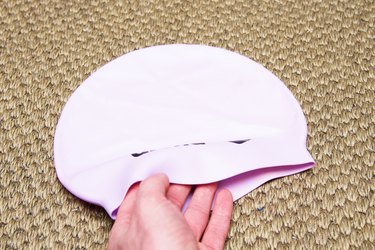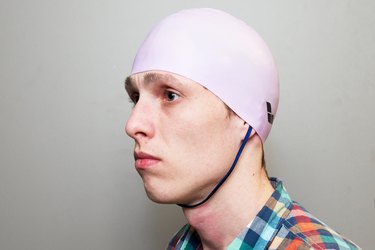
Swimmer's ear is the main reason to wear a swim cap. It is an infection of the ear canal, acute external otitis or otitis externa, and is characterized by itching, redness, discomfort or drainage in the ear canal. You may also experience pain, pus, a feeling of fullness or muffled hearing.
Using a swim cap to protect your ears while swimming may help reduce your risk of developing swimmer's ear, since it helps keep your ears dry. Talk to your doctor before swimming with an infected ear or before trying any home remedies for swimmer's ear. They might allow you to swim if you show that you can properly protect your ears.
Video of the Day
Video of the Day
Step 1

Purchase a swim cap designed with ear pockets. This kind of cap stands a much better chance of covering your ears in the first place, staying put over your ears and forming a watertight seal.
Step 2

Consider using a cap with a chin strap; this will also help the cap stay put over your ears.
Step 3

Put your swim cap on properly. Place the inside edge of the swim cap against your forehead, then slowly draw it back and down over your head. If you have long hair, stop with the cap halfway on to tuck your hair under the cap, then pull it down all the way.
Step 4
Use waterproof earplugs, if necessary, to defeat the minimal amount of water that sometimes enters a swim cap no matter how hard you try for a waterproof seal.
Tip
Avoid Lycra swim caps -- because they’re not waterproof -- unless you cover it with a waterproof silicone or latex cap that comes down all the way over your ears.
Never tie your hair into a ponytail before putting the swim cap on, because this creates an unusual shape that’s likely to let water in; thus defeating all your effort to protect your ears.
Otitis externa, or swimmer's ear, is an ear infection that affects the external ear and outer ear canal. Symptoms of swimmer's ear can include inflammation of the ear, itchiness inside the ear, pain when the ear is pulled or when the head is tilted, and infection leaking from the ear. The Centers for Disease Control indicate that swimmer's ear most often affects children and young adults. Protect your family by practicing proactive methods of protecting your ears while swimming.
Step 5
Avoid swimming in bodies of water that may be contaminated. Check for regular cleaning and disinfecting schedules if using a public pool; check for pollution level warnings before planning a swim in local rivers, lakes or ponds.
Step 6
Wear a swimming cap to help protect your ears from getting wet while you are swimming. It is important to put the swimming cap on properly with the ears completely covered. To put the swimming cap on, place your hands inside the cap with fingers laced. Stretch the swimming cap open. Lean forward and slide the cap on, slowly moving your hands downward as the cap slides onto your head. Once the swimming cap reaches your ears, remove your hands completely and tug the cap down until your ears are covered.
Step 7
Wear ear plugs as an alternative to a swimming cap to prevent water from entering the outer ear canal. Ear plugs come in both disposable and reusable versions; people who do not have latex allergies should consider using reusable latex plugs. Follow the manufacturer's instructions for application, taking care not to push the plugs in too deeply.
Step 8
Dry your ears thoroughly after exiting the water. Use a clean, soft towel to gently pat your outer ear dry. Tilt your head to the side to allow any water that has gotten into the inner ear to drain out. Repeat the process with the other ear. Another option for getting ears completely dry is to use a blow dryer. Set the blow dryer to its lowest setting. Hold the blower dryer approximately a foot out away from your ear and then turn it on. Keep the blow dryer aimed on your ear for about 30 seconds. Repeat for the other ear.
Step 9
Apply a preventive home remedy. The Cleveland Clinic recommends creating a mixture that is one part vinegar and one part rubbing alcohol to apply to the ears before and after swimming as a possible way to prevent bacteria that can cause swimmer's ear. Tilt your head and use a medicine dropper to apply one drop of the mixture into your ear. Hold for 10 seconds and then allow the mixture to drain out. Repeat for the other ear.
Things You'll Need
Clean towel
Swimming cap
Ear plugs
Blow dryer
Tip
When drying your ears after swimming, tilt your head and pull your earlobes in different directions to help drain the water.
Warning
If you have pain or discomfort inside your ear or pus oozing from your ear, consult your health care provider.